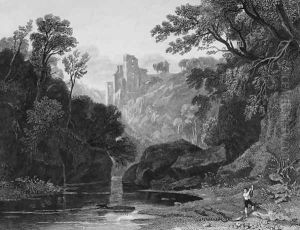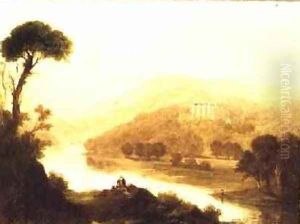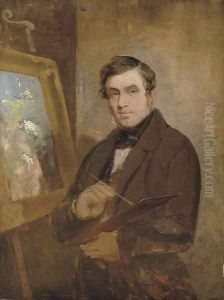Thomson, Rev. John of Duddingston Paintings
Reverend John Thomson of Duddingston was a notable Scottish landscape painter and minister born in 1778 in Dailly, Ayrshire. He became known for his artistic talents as much as for his ecclesiastical role. Thomson attended the University of Edinburgh, where he initially studied divinity and later joined the Royal High School to study art under Alexander Nasmyth, a leading landscape painter of the time. His dual interests in religion and art continued throughout his life.
Thomson was appointed minister of Duddingston, Edinburgh, in 1805, where he served until his death in 1840. His parish duties did not hinder his passion for painting, and he often found inspiration in the landscape around Duddingston Loch and the Holyrood Park, which was adjacent to his parish. His work is characterized by dramatic Scottish landscapes, often with a romantic and atmospheric quality that reflects the influence of his contemporaries, such as Nasmyth and the broader Romantic movement in art.
His paintings often featured the natural beauty of the Scottish countryside, including its rugged mountains, serene lochs, and dramatic skies. Thomson's ability to capture the changing light and weather conditions contributed to the sense of emotion and atmosphere in his work. Despite his talent and the quality of his artwork, Thomson never sought to profit from his paintings, instead gifting them to friends or painting for his own pleasure.
Reverend John Thomson's contributions to Scottish art were recognized by his peers, and he was associated with a group of Scottish artists known as the Edinburgh School. Although he did not exhibit extensively during his lifetime, his work was later shown posthumously, and he is now regarded as an important figure in the history of Scottish landscape painting. Thomson's legacy also includes his influence on other artists of the time, including Sir William Allan and Horatio McCulloch, who were known to have admired his work.
Thomson died in 1840, but his paintings continue to be appreciated for their romantic portrayal of the Scottish landscape and their role in the development of Scottish art in the 19th century. His work can be found in various art collections, including the National Galleries of Scotland, where his artistic achievements and unique blending of his clerical and artistic vocations are celebrated.


